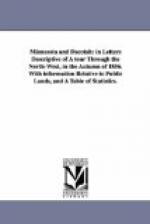But there are several thrifty and pleasant villages in Minnesota, on the river, before reaching St. Paul. The first one of importance is Brownsville, where, for some time, was a United States land office. It is 168 miles above Dunleith. Winona, 58 miles farther up, is a larger town. It is said to contain 5000 population. There is a land office there also. But the town stands on land which, in very high water, will run too much risk of inundation. Passing by several other landings and germs of towns, we come to Wacouta, ninety-eight miles above; which is a successful lumber depot. Six miles further on is Red Wing, a place which delighted me on account of its cheerful location. It is growing quite fast, and is the seat of a large Methodist seminary. But the town of Hastings, thirty-two miles above, eclipses everything but St. Paul. It is finely located on rising ground, and the river is there narrow and deep. The boat stopped here an hour, and I had a good opportunity to look about the place. The town appears to have considerable trade with the back country. Its streets are laid out with regularity; its stores and buildings are spacious, durable, and neat. I heard that over $2000 were asked for several of the building lots. A little way into the interior of the town I saw men at work on a stone church; and approaching the spot, I determined to make some inquiries of a boy who was briskly planing boards. First, I asked how much the church was going to cost? About $3000, he replied.
“Are there any other churches in the place?”
“Yes, up there, where they are building.”
“What denomination is that?”
“I don’t know,” he responded. “I only came into the place yesterday.”
I thought he was doing well to begin to build churches so soon after his arrival. And from his countenance, I have no doubt he will do well, and become a useful citizen of the state. Hastings has its democratic press— the Dakota Journal, edited by J. C. Dow, a talented young man from New Hampshire. The population of the town is about two thousand. It is thirty-two miles below St. Paul, on the west side of the river. There is nothing of especial interest between the two places.




